by Winding Pathways | Dec 7, 2023 | (Sub)Urban Homesteading, Birds, Nature
Why do Birds Fly Into Windows?
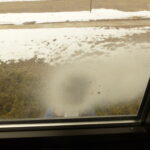
The spray makes the window opaque.
Windows, deadly for birds. According to the National Audubon Society, about one billion birds are killed every year when they crash into windows. About half collide with low commercial building windows with the rest crashing into home windows. Surprisingly few seem to crash into the high windows of skyscrapers.
Birds fly into windows because they just don’t see them and assume they’re about to zip through safe soft air. Sometimes they may see reflections of vegetation behind them and think they are zooming to a convenient perch.
How to Help a Bird
When Rich was director of the Indian Creek Nature Center, he’d often get calls from upset people who had just found a quivering bird beneath their window. In his experience one of two outcomes is likely. Either the bird will soon die or it will fully recover and fly off. He suggests leaving the bird alone for at least an hour unless it’s likely to fall prey to a hungry neighborhood cat. In that case, it is probably best to gently place it in a cardboard box to give it a chance to recover…or die.
Unfortunately, there’s no effective first-aid technique to reverse death. Hopefully, the bird will soon recover and speed away. If not, a respectful burial is in order.
Tips
Here are some tips from the Portland, Oregon, Audubon Chapter of the National Audubon Society for reducing window collisions:
- Place bird feeders away from large windows.
- Avoid putting house plants immediately inside windows. Birds may see them and attempt to fly to a perch.
- Put stickers/decals on the outside of windows. (Note: Many sources recommend these. Stickers can be bought online or at bird-feeding stores……but we, at Winding Pathways, have not found them very effective.
- Stretch netting across the outside of the window to physically keep birds from crashing. We’ve found this best on windows that experience frequent bird collisions.
- Put colorful tape on the outside of the windows.
- Douse outside lights. Come sundown our nation is way over-lit. Lights block viewing the magnificent night sky while often disorienting migrating birds.
We Can Help
Songbirds face many challenges in our modern world. They crash into windows, hit poles, get gobbled up by house cats, and are confused by electric lights. They need all the human help they can get to stay alive and healthy.
by Marion Patterson | Apr 13, 2023 | Amphibians/Reptiles, Birds, Flowers/Grasses, Hearing, Nature, Wonderment
A Season of Variables
After a drab March “look up, look down, listen” season is here. It’s exciting and frustrating. Always something to see and hear and things we miss, too.
What is look up, look down, listen? Well, when we walk in woods and prairies, we’re always attuned to nature’s beauty and curiosities. In the Northern Hemisphere April and May force challenges and delights, as the earth turns toward the sun. Its warmth stimulates new life while welcoming arrivals from down south.
Here in Iowa, like much of the United States, bird migration rises through April and peaks in early May. Woods, wetlands, and prairies are filled with bird species we haven’t seen since last year.
Look Up!
“Look up,” Marion remarked on one April walk last year. She spotted the first Rose Breasted Grosbeak of the season. He was perched on a thin branch high in a sycamore tree. As we walked along, we kept looking up to spot other new arrivals. They added color and song to those of cardinals, chickadees, and woodpeckers who are our neighbors all year.
-
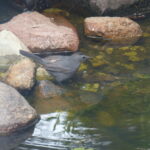
-
A catbird drinks by a pool.
-
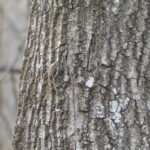
-
The brown creeper blends in with tree trunks.
Look Down!
After admiring the Grosbeak and moving on, I said, “look down.” We had been paying so much attention to birds up in the trees that we almost trampled a Dutchman’s Breeches, a delicate white wildflower with petals shaped like old-time Dutch pants. Looking down revealed spring beauties, Mayapples, hepatica, and anemones. Some were not quite in bloom and a few had gone by, but most were in their spring glory.
-
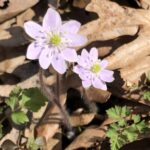
-
Early spring flowers
-
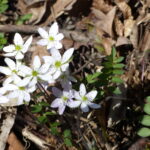
-
Reaching for the sun
-
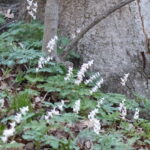
-
Dutchman’s Britches
-
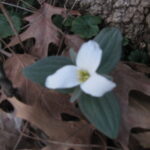
-
Snow Trillium
Shhhh! Listen
Passing a low wetland, we both paused to hear the songs of the chorus frogs and peepers that greet listeners each spring between the vernal equinox and Easter.
So, what do we do on a spring walk? Look up or down or listen? All of these. It is the best time of year to enjoy beauty clinging to the soil, singing from treetops, and chorusing from ephemeral pools.
Make Nature ID easier with Apps
Spotting birds hiding invisibly in tangles of branches and vines is challenging. What’s in that thicket singing? Thanks to the Cornell Laboratory of Ornithology, we turn on our Merlin app, point the phone where the songs originate, and learn who’s singing. Merlin is easy to download from the app store. Sometimes we are lucky and watch migratory birds close at hand.
Some people even lure birds in with treats that are eagerly consumed by arriving birds.
Wildflowers cannot hide but can be confusing. We sometimes use an app called SEEK to identify ones that are mysterious to us. SEEK is also easy to download from the app store and can also help identify trees, weeds, and other living things.
Look up, look down, listen! season may be the very best time to be outside. We love it.
by Winding Pathways | Oct 27, 2022 | Birds, Nature
Hi all: Many people either don’t have feeders for birds or have reduced their giving of seeds due to higher expenses. Yet, we still like to note birds around. We encourage you to join Cornell University’s Project FeederWatch. From the website click on “About” on the tab and read more details of how you can enjoy watching and documenting birds starting November 1st.
-
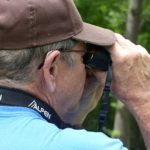
-
Bird watching is again a joy with hearing aids.
-
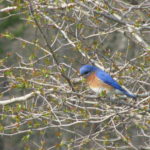
-
Bluebirds hang out on branches.
-
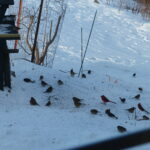
-
Birds flock to the seeds.
-
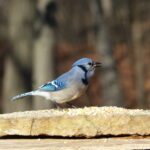
-
Usually jays come around only in winter.
-
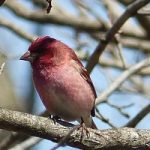
-
Some birds homestead at Winding Pathways.
-
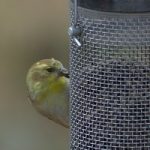
-
Songbirds appreciate high quality seed to sustain them in winter.
-
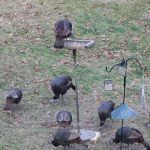
-
Turkeys and squirrels would make short work of seed, leaving none for the small birds.
-
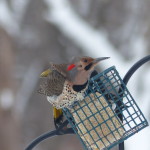
-
Winter is tough on birds so keep your feeders full.
-
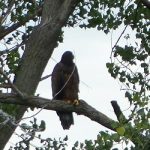
-
Fledgling eagle resting in the back yard.
by Winding Pathways | Sep 15, 2022 | (Sub)Urban Homesteading, Birds, Garden/Yard, Mammals, Nature, Pests
Guest Blog by Jackie Hull,
in the foothills of Virginia
Bears Barely Tolerable Behavior
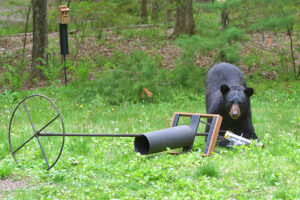
Bear Raiding Feeders
Well, the bear did it again. It tore up some of the spindles on the porch railing, tipped over a couple of the vegetable pots, and yanked a six-foot portion of our picket fence off the posts. All this to remind me that I should not feed the birds this time of year. It’s May.
So what to do but put away all the feeders? Maybe I can try again in the fall when bears retreat to the dens for their winter snooze.
This pretty much gave me great moments of sadness especially since I’ve had to shed other favorite activities.
Bird Antics Bring Joy
But today was a day of great surprises. My beautiful main stays, the birds, were everywhere. As I sat in the kitchen peering out the window, I spotted the adult turkeys poking their heads above the uncut hay. I could feel their parental thoughts “The coast is clear so keep scrambling forward.” The chicks were not seen but definitely there. A goldfinch zipped over them. Then I saw two wood thrashers near the holly tree scavenging for insects. Oh, my look how that crow struts!
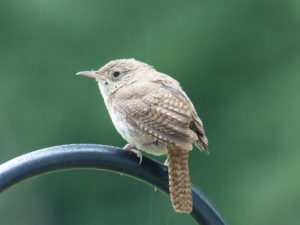
Wrens are Chatterers
Listen, that’s the wren by the back door. She keeps chattering to remind me she built her condo in the hanging planter. Then a flash of bright red caught my eye as I walked onto the porch. It’s a cardinal. Then the female house finch flicked from her nest over the front door light. She doesn’t like me stepping onto the porch. She is quite timid.
Even though the feeders have been down for nearly two months, the birds have kept their vigil at my country home much to my delight. They are in the trees, along the lane, and in the hayfield. What a great day!
by Winding Pathways | Sep 8, 2022 | (Sub)Urban Homesteading, Birds, Nature
Sometimes an animal’s name is misleading. Take the common nighthawks. It’s not a hawk and it doesn’t only fly at night. We often sit evenings on our back deck at Winding Pathways. In late summer 2022, we have been treated as dozens of aerial dancers – nighthawks – wheel overhead stalking mosquitoes and other insects. They can have all they can catch!
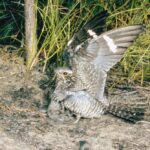
Common Nighthawks blend in with the ground. courtesy Free Photos
These birds are wonders. Closely related to whip-poor-wills, the brown feathers of the common nighthawk render them nearly invisible when resting in dry leaves or gravel during the day. They love evenings and wing overhead with their massive mouths open to snare tasty insects from the air.
Sometimes they pass just a few feet overhead. Occasionally they’re so high up that they are just fast-moving-turning-on-a-dime specks. Always they show distinct white stripes on the underside of their pointed wings.
Habits of Nighthawks
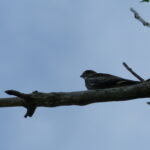
Resting nighthawk
We watched dozens of them in September 2022 and know that like many other migratory birds, they’ll join other birds for winter quarters in South America, so we enjoy them when we can. Daily we track bird migrations on the birdcast.info site. Nighthawks are one of the most widespread of North American birds, visible over farms, forests, and cities. Sometimes they even nest on gravel surfaced roofs of commercial buildings downtown and gravel areas of yards. We’ve caught glimpses of them resting on tree limbs. Watch the video to see many characteristics of nighthawks – their flight, sounds (listen for the “boom” of their wings), resting habits like sinking into the ground and yawning, and toward the end of this mini-documentary -the “waddle.” Fun!
Unfortunately, nighthawks have been declining about 1% a year since the 1960s. Why??? Pesticides, perhaps, reduce the insects that nighthawks feed on, and the loss of habitat. We don’t know for sure, but we enjoy watching their evening sky dance and hope people help them reverse their decline to continue their sky dance over much of the continent gobbling up insects.




















